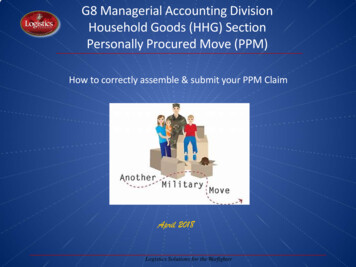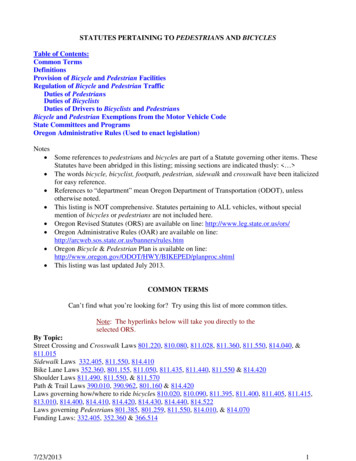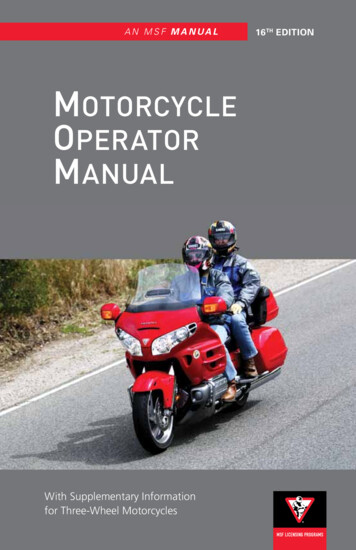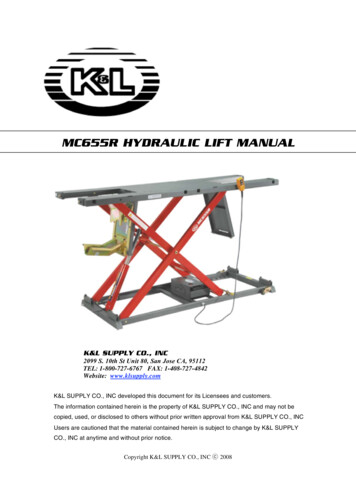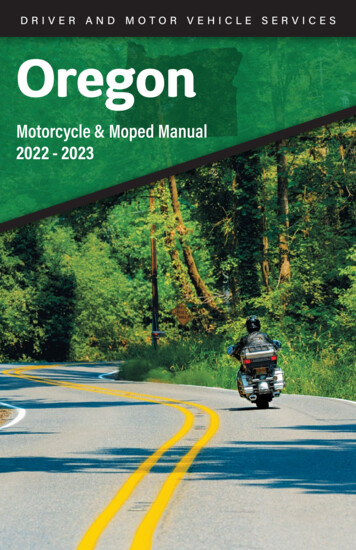
Transcription
DRIVER AND MOTOR VEHICLE SERVICESOregonMotorcycle & Moped Manual2022 - 2023
Visit us at our web sitewww.OregonDMV.comPublished byOregon Department of TransportationDriver and Motor Vehicle Services1905 Lana Avenue NESalem, Oregon 97314Graphics/LayoutDMV Related Questions: (503) 945-5000ODOT is an Equal Employment Opportunity andAffirmative Action Employer.ODOT does not discriminate on the basis of disability in admissionor access to our programs, services, activities, hiring, and employmentpractices. To report any complaints or concerns related todiscrimination, please call:1-877-336-6368 (EEO-ODOT).This information can be made available in an alternative format bycontacting a local DMV field office.The majority of the content of this manual is directly from theAmerican Association of Motor Vehicle Administrator’s MotorcycleOperator Manual, with inserts from Motorcycle Safety Foundation,Team Oregon and particulars of Oregon law.
The purpose of the Oregon Motorcycle & Moped Manual is to help riders prepare forOregon endorsement tests by providing a summary of the rules of the road and saferiding practices.This manual condenses and paraphrases selected language in the Oregon RevisedStatutes. It also provides safety recommendations not included in law. This manual isnot a source of law and should not be relied upon or cited as legal precedent in a court oflaw or other administrative or legal proceeding. Local governments may have additionalordinances not covered in this manual.Please check DMV’s website OregonDMV.com for updates, office locations and hours, feesand additional information.iv
ContentsSection One. 1Riding in Oregon.1Motorcycles and Mopeds.1Riding Mopeds, Autocycles, Mini-Motorcycles,Pocket Bikes, ATVs and Off-Road Motorcycles.4Section Two . 6Factors Affecting Rider Performance.6Effects of Alcohol and other Impairing Drugs.6Other Factors Affecting Rider Performance.8Section Three .11Before You Ride.11Selecting and Wearing Protective Gear.11Know Your Motorcycle .14Required Motorcycle Equipment .16Section Four .18Vehicle Control Skills.18Getting Started.18Shifting Gears .20Stopping .21Turning.22v
Section Five .24Street Strategies.24Rider Risks and Responsibilities .24SIPDE.25Intersections .26Sharing the Road.28Increasing Visibility .32Section Six .35Roadway Management.35Crash Avoidance.35Handling Hazardous Surfaces.38Section Seven .41Special Riding Situations.41Section Eight .45Passengers, Cargo and Group Riding.45Carrying Passengers and Cargo.45Group Riding .47Section Nine .49Three-Wheel Motorcycles.49Common Operating Characteristics of Three-WheeledMotorcycles and Motorcycles with a Sidecar.49Unique Operating Characteristics of Triple-TrackMotorcycles .51Unique Operating Characteristics of a Motorcyclewith a Sidecar .52vi
ONESection OneRiding in OregonMotorcycles and MopedsMotorcycles and mopeds are defined as vehicles designed to travel with no morethan three wheels in contact with the ground and with a seat or saddle for use bythe rider.A moped must have an independent power source that is a power drive systemthat functions directly or automatically and does not require clutching orshifting by the operator after the system is engaged. A moped cannot be capableof speeds of more than 30 mph on level ground AND, if the moped’s powersource is a combustion engine, it cannot be larger than 50 CCs. Mopeds alsoinclude cycles designed as bicycles, if they are equipped with a power sourcemeeting the legal definition.Mandatory Rider EducationIf you need to obtain a motorcycle endorsement and you do not have a validmotorcycle endorsement or license from another state, the District of Columbia,a United States Territory or Canadian Province, you must complete an approvedmotorcycle rider education course.Team Oregon is the only approved motorcycle rider education provider in Oregon.You can find information and sign up for courses at www.team-oregon.org.Following are approved Team Oregon courses and the tests that a completioncard waives at DMV: Basic Rider Training (BRT) is approved for riders 16 years of age and olderand waives both the motorcycle knowledge and skills tests. Intermediate Rider Training (IRT) is approved for riders 21 and older andwaives only the motorcycle skills test. eRider Basic is approved for riders 16 years of age and older and waives onlythe motorcycle skills test. eRider Intermediate is approved for riders 21 and older and waives only themotorcycle skills test.Riders who complete an approved motorcycle rider education course may qualifyfor a discount on the insurance premium for their motorcycle.1
ONERiding UnendorsedRiding a motorcycle without a motorcycle endorsement is a Class A trafficviolation.Studies show that 30% of motorcycle riders involved in fatal crashes in 2019 wereriding without a valid motorcycle endorsement.1Mandatory InsuranceOregon’s insurance law requires every driver to insure their vehicle, including amotorcycle or moped, if it is operated on any highway or on premises open to thepublic. The minimum amount of liability insurance required is: Bodily injury and property damage liability — 25,000 per person; 50,000per crash for bodily injury to others; and 20,000 per crash of damage toproperty of others. Uninsured motorist coverage — 25,000 per person; 50,000 per crash forbodily injury.Instruction PermitsMoped – There is no instruction permit available for a moped.Motorcycle – In order to be issued a Motorcycle Instruction Permit you must: Have a valid driver license from Oregon. Be at least 16 years of age. Have parental/guardian consent if under age 18. Pass the motorcycle knowledge and vision tests.A motorcycle permit is valid for one year. The permit allows you to learn howto safely operate a motorcycle on public streets and highways. You should learnbalance and control of the motorcycle off the street.Restrictions on a Motorcycle Instruction Permit: Rider must be accompanied by, and under the supervision and visualobservation of, a rider on a separate motorcycle who is at least 21 years of ageand who has a valid motorcycle endorsement. Rider must operate during daylight hours only. Passengers are prohibited. Rider must wear a DOT compliant helmet.Three-Wheel Motorcycles – There is no instruction permit available for a threewheel motorcycle.12National Center for Statistics and Analysis (2021, April). Motorcycles: 2019data (Traffic Safety Facts. Report No. DOT HS 813 112). Washington, DC:National Highway Traffic Safety Administration.
Moped – You may operate a moped with any class of driver license. Noendorsement is required.ONEEndorsementsIf you are riding a moped or cycle that has an independent power source andcan go over 30 mph on level ground, unassisted, you must have a motorcycleendorsement.If you are riding a moped or cycle equipped with a combustion engine powersource of more than 50 CCs, you must have a motorcycle endorsement.Motorcycle – In order to be issued a motorcycle endorsement: You must have a valid driver license from Oregon. You must be at least 16 years of age. You must have parental/guardian consent if under age 18. You must complete a Team Oregon motorcycle rider education course.Depending on the Team Oregon course completed, you may be required totake and pass the DMV motorcycle knowledge test.If you have a valid out-of-state motorcycle license or endorsement, you mustsurrender your license or endorsement from another state, District of Columbia,a United States Territory or Canadian Province. You are not required to take aTeam Oregon course or take the motorcycle knowledge test with DMV.Three-Wheel Motorcycle – This restricted endorsement allows you to operateonly three-wheel motorcycles.In order to be issued a three-wheel restricted motorcycle endorsement you must: Have a valid driver license from Oregon. Be at least 16 years of age. Have parental/guardian consent if under age 18. Take and pass the DMV Motorcycle Knowledge test.If you have a valid out-of-state three-wheel restricted motorcycle license orendorsement, you must surrender your license or endorsement from another state,District of Columbia, a United States Territory or Canadian Province. You arenot required to take a Team Oregon course or take the motorcycle knowledge testwith DMV.Motorcycle endorsement fees and issuance requirements may vary. Please visitour website at OregonDMV.com for more information.3
ONETesting at DMVVision – You must take and successfully pass a vision screening to add amotorcycle endorsement to your Oregon Driver License.Knowledge – The knowledge test is based on information in this manual and thequestions are multiple choice. The test is 5.00 and you must answer 20 questionscorrectly to pass.You cannot use a DMV manual or any notes to help you answer test questions.Talking, writing, note taking, cell phone use, operation of any electronic devicesor allowing someone else to take a test for you is considered cheating.Skills – DMV does NOT administer motorcycle skills tests. The motorcycle skillstest is waived when you take and successfully pass an approved Team Oregoncourse.If you have a valid motorcycle endorsement from another state, you are notrequired to take the motorcycle knowledge or skills tests.Riding Mopeds, Autocycles, Mini-Motorcycles, Pocket Bikes, ATVsand Off-Road MotorcyclesRiding MopedsMoped operators in Oregon generally obey the same rules of the road asmotorcycle operators.Motorcycles and mopeds, while similar in appearance, differ in the way theyoperate. Motorcycles are heavier and more powerful. Mopeds may have a topspeed, unassisted, of no more than 30 miles per hour while on a level surface.Since they are not built the same, mopeds and motorcycles should not be used forsome of the same purposes. Mopeds are designed for traveling short distances atlow speeds. Oregon law allows a moped to use bicycle lanes or paths if the mopedis being pedaled. When under its own power, a moped must use regular trafficlanes. It is against the law to carry passengers when operating a moped.AutocyclesAutocycles handle much differently than motorcycles or mopeds. These vehiclesoperate more like a car because they are equipped with three wheels, a nonstraddle seat and a manufacturer-installed three-point safety belt or safetyharness.An autocycle may be operated with any class of driver license. A motorcycleendorsement is not required. Operators and their passengers must wear a DOTcompliant helmet if the autocycle is NOT enclosed. An enclosed cab is defined ashaving a structural upper frame and roof certified by the vehicle manufacturer,meeting the §49 CFR 571.216a standards. Autocycles may not ride more thanone abreast in a lane.4
A mini-motorcycle, pocket bike, go-kart or all-terrain vehicle (ATV) is notlegal for use on public roads in Oregon. To be legal on public roads, motorizedvehicles, including motorcycles, need to meet the U.S. Department ofTransportation’s vehicle design safety and equipment requirements and U.S.Environmental Protection Agency (EPA) emission standards. For a quickreference guide, visit our website at: orcycles, Pocket Bikes, ATVs and Off-Road MotorcyclesMotorcycles originally manufactured for off-road use generally do not meet theemission standards for on-road use and cannot be registered for highway use inOregon. For information about converting an off-road motorcycle to street use,visit the Transportation Safety Office’s website at: x.Out of state? Call 503-945-5000If you are temporarily living out of state, you may complete an approvedmotorcycle rider education course in that state. You must apply for a motorcycleendorsement within two years from when you complete the course, unless thecourse completion card expires sooner.These courses are approved by DMV: Motorcycle Safety Foundation (MSF) Basic Rider Course; Idaho Skills Training Advantage for Riders (STAR); California Motorcyclist Safety Program (CMSP) Motorcyclist TrainingCourse; Total Control Riding Clinic; and Motorcycle Ohio Rider Enhancement (MORE).5
TWOSection TwoFactors Affecting Rider PerformanceRiding a motorcycle demands your full attention. Responsible riders payattention to the riding environment, identify potential hazards, look for escaperoutes and make good decisions.Your ability to trust your judgment and to be aware of changing conditions orpotential hazards is influenced by how mentally fit and alert you are.Alcohol is a major contributor to motorcycle crashes, particularly fatal crashes.Studies show that, in Oregon, 43% of all riders killed in motorcycle crashesduring 2019 had been drinking.2 Riding “under the influence” of alcohol or otherdrugs poses physical and legal hazards for every rider.Effects of Alcohol and other Impairing DrugsIt is important to understand the effect of alcohol, marijuana and other drugs tosee that they don’t mix with riding. Alcohol and other drugs impair your:Judgment – Alcohol and other impairing drugs affect those areas of your brainthat control judgment. You may not be able to make good decisions about trafficconditions or how you can protect yourself.Vision – Alcohol and certain types of drugs can blur your vision, slow yourability to focus and cause double vision.Reaction Time – Alcohol and other impairing drugs slow your ability to processinformation and impact your ability to react quickly to a situation.Riding under the influence of alcohol or other drugsposes physical and legal hazards for every rider.26National Center for Statistics and Analysis (2021, April). Motorcycles: 2019data (Traffic Safety Facts. Report No. DOT HS 813 112). Washington, DC:National Highway Traffic Safety Administration.
The safest and most responsible choice is tonot drink and ride. Your ability to thinkclearly and ride safely is affected by aslittle as one drink. Once you start, yourjudgment is affected and your ability tosay “no” gets weaker.If you plan on drinking, leave yourmotorcycle at home and find othertransportation so you won’t be tempted toride impaired. Or, call ahead to where you planon drinking and ask if there is a secure place foryou to store your motorcycle overnight so you can find analternative way home – such as a taxi or designated driver.TWODon’t Drink and RideThere are no shortcuts to removing alcohol from your body. None of the“remedies” you may have heard about – cold showers, hot coffee, or physicalexercise – will remove alcohol faster. The only proven remedy to removing alcoholis time. Remember – your body can process about one drink an hour.Other Impairing Drugs and RidingMarijuana and other cannabis products slow your reaction time, interfere withyour concentration, impact your perception of time and distance and affect yourability to ride safely. Its negative effects are most evident when individuals handlingmultiple tasks are confronted with something unexpected. Your response andperformance at these times need to be quick and accurate.Many prescription, over-the-counter and illegal drugs may also affect your ability toride safely. If you are not sure if it is safe to take a drug and ride, ask your doctor orpharmacist about any side effects.Never drink alcohol while you are taking other drugs. These drugs could multiplythe effects of alcohol or have additional effects of their own. These effects not onlyreduce your ability to operate your motorcycle, but could cause serious healthproblems, even death.Combining drinking and drug use with the operation of a motor vehicle can havefatal consequences. Motorcyclists are more likely than automobile drivers to bekilled or severely injured in crashes.7
Other Factors Affecting Rider PerformanceTWOTWODistracted RidingA distraction is anything that takes your attention away from riding. Riderdistractions may occur anytime and anywhere. Distracted riding can causecollisions, resulting in injury, death or property damage. Taking your eyes off theroad or hands off the motorcycle presents obvious riding risks. Mental activitiesthat take your mind away from riding are just as dangerous. You must maintainyour attention on the riding task. You are completely and solely responsible foroperating your motorcycle in a safe manner.HealthThere are many health conditions, even minor issues, that can affect your riding.Check with your doctor if a health condition could interfere with you operating amotorcycle.EmotionsEmotions can interfere with your ability to think, create mental distractions,increase risk-taking, create a lack of attention and interrupt your ability toprocess information. You may not be able to give all your attention to operating amotorcycle if you are overly worried, excited, afraid, angry or depressed.FatigueFatigue can affect your control of the motorcycle. To minimize potential forfatigue, be sure to be properly rested and take frequent rest breaks when riding longdistances. Experienced riders seldom try to ride more than about six hours a day.WeatherRiding a motorcycle requires a great amount of mental alertness and physicalskill. Sometimes changes in your environment can affect your visibility. Physicalchanges may occur as well, such as rain or wind, which may affect your ridingperformance. Responsible riders know how to adjust or compensate for factors thataffect rider performance.Cold WeatherIn cold weather riding, protect yourself by wearing proper protective gear like awindproof jacket and insulated layers of clothing. An additional windproof outerlayer can prevent cold air from reaching the skin.Cold weather can significantly impact your reaction time. To compensate for theslower reaction time, reduce your speed and increase your following distance andspace on your sides.8
HypothermiaSymptoms of hypothermia may include: Deterioration in physical coordination. Irrational, confused behavior. Sluggish movement. Shivering. Muscle tension. Shallow, slow breathing.TWORiding for long periods in cold weather may lower your body temperature andcause hypothermia.If a chill is experienced, leave the roadway at your first opportunity and findshelter. Drink warm liquids, do some exercise to warm yourself and change out ofwet clothes.Extreme Hot WeatherIn extreme hot weather, wear protective gear that breathes. It is important to weara jacket and long pants to protect you in a collision and to prevent dehydration.Drink plenty of water, stop and remove unnecessary heavy clothing and dry yourhands if they become slippery due to perspiration.Symptoms of heat stroke may include: Throbbing headache. Feeling dizzy or light-headed. Muscle weakness or cramps. Nausea and vomiting. Rapid heartbeat, which may be strong or weak. Rapid, shallow breathing.9
Test Your Knowledge1. What is the only proven remedy to remove alcohol from your body? (Page 7)TWOA. Hot coffee.B. Time.C. Physical exercise.2. Prescription drugs: (Page 7)A. Always help you ride safer.B. Are safe to use while riding.C. Can affect your ability to ride safely.3. To compensate for the slower reaction time in very cold weather, you should:(Page 8)A. Ride close to other vehicles.B. Speed up.C. Increase your following distance.10
Section ThreeA responsible rider makes a point to:1. Wear protective riding gear.2. Be familiar with the motorcycle.3. Inspect the motorcycle.THREEBefore You Ride4. Be free of impairments (alcohol and drugs).Selecting and Wearing Protective GearAnytime you ride a motorcycle: You must wear a helmet compliant with U.S. Department of Transportation(DOT) standards. You should wear face and eye protection. You should wear motorcycle protective riding gear (gloves, long pants, jacketand sturdy footwear).Helmet UseOregon requires you to wear a motorcycle helmet whenever you ride amotorcycle, moped or unenclosed autocycle as either an operator or passenger.Here are some facts to consider: Helmets protect you from the elements (wind, bugs, debris, etc.). A DOT-compliant helmet does not restrict vision or mask important sounds. Crashes are unpredictable and may happen at any time, even on short rides orwithin minutes of starting the ride. Regardless of speed, a helmet will reduce the chances of severe or fatal headinjuries.11
elmet SelectionProtection should be the first consideration when buying your motorcycle helmet.There are three primary types of helmets: full-face, three-quarter, and half. Afull-face helmet gives the most head protection since it covers all of the head andface. This design has a flip-up face shield that protects the eyes. A three-quarterhelmet affords riders good head protection and is constructed with the same basiccomponents, but doesn’t offer the face and chin protection of full-face helmets. Ifyou wear a three-quarter helmet, you should use an approved snap-on face shieldor goggles. Half helmets provide the least amount of protection.Whichever style you choose, make sure that the helmet: Is DOT compliant. You can tell if a helmet is DOT compliant if it has a labelattached to the helmet thatstates the manufacturer’s nameand/or brand, model, andsays DOT, FMVSS No.218,CERTIFIED. Has no obvious defects such ascracks, loose padding or frayedstraps.Back ofInside ofHalfHelmetHalfHelmet Fastens securely.Mfr. Name and/or BrandModel DesignationDOTFMVSS No. 218CERTIFIEDHelmet FitA helmet should fit comfortably, but snug all the way around. A helmet that istoo loose can lift in the wind or come off your head in a fall. One that is tootight can create sores or cause headaches. When choosing a helmet, try on severalbrands and sizes to get an idea of fit and comfort.Here are a few tips for the best fit: Cheek pads should touch your cheeks without pressing uncomfortably. There should be no gaps between your temples and brow pads. If the helmet has a neck roll, it should not push the helmet away from theback of your neck. On full face helmets, press on the chin piece. The helmet or face shield shouldnot touch your nose or chin.12
Face and Eye ProtectionWindshields will not protect your eyes from wind and debris; neither willeyeglasses or sunglasses. A windshield is not a substitute for a face shield. Glasseswill not keep your eyes from watering, and they might blow off when you turnyour head while riding. Goggles protect your eyes but won’t protect the rest ofyour face like a face shield does. Goggles can also reduce peripheral vision. Tintedeye protection or shields should not be worn at night or any other time when littlelight is available.THREEWithout face protection, an object could hit you in the eye, face or mouth. Afull-face helmet provides the maximum face and eye protection while riding andin the event of a crash. A plastic shatter-resistant face shield can help protect youreyes and face from wind, dust, dirt, rain, insects and pebbles thrown up fromvehicles ahead. These distractions can be painful and can take your full attentionfrom the road. Whatever happens, keep your eyes on the road and your hands onthe handlebars.Hearing ProtectionLong-term exposure to wind noise can cause irreversible hearing damage.Properly worn hearing protection can reduce wind noise and make your ridemore enjoyable while still allowing you to hear important sounds like car hornsand sirens. You can choose from a variety of styles from disposable foam plugs toreusable custom-molded devices.Protective Riding GearRiding gear designed for motorcycle riders provides protection in the event ofa crash as well as from heat, cold, rain, debris and hot or moving parts of themotorcycle. Sturdy synthetic or leather materials provide the best protection.Wearing brightly colored clothing with retro-reflective material will make youmore visible to other roadway users.Sturdy synthetic or leather materials provide thebest protection. Jackets and Pants should cover arms and legs completely and be made ofdurable material. Jeans do not provide adequate protection. Wear a jacket evenin warm weather to prevent dehydration. Many motorcycle riding jackets aredesigned to protect without getting you overheated, even on summer days. Protective Footwear provides protection for the feet, ankles and lower partsof the legs. They should be high and sturdy enough to cover your ankles andgive them support. Leather boots are best. Soles should be made of hard,durable slip-resistant material. Keep heels short so they do not catch on roughsurfaces. Tuck laces in so they won’t catch on your motorcycle.13
Gloves allow a better grip and help protect your hands. Your gloves should befull-fingered and made of leather or similar durable material. Rain Suits designed for motorcycle riding resist tearing apart or ballooning upat high speeds. You will be much more comfortable and alert than a rider whois wet and cold. One- or two-piece styles are available. A rain suit with retroreflective strips or high visibility orange or yellow colors are good choices.THREEWhatever the weather conditions, always wear protective gear that will keep youcomfortable, enabling you to concentrate on your riding.Know Your MotorcycleYou should get to know yourmotorcycle. Learning howthings work and what partsneed the most attentioncould reduce your chances ofbeing in a crash and extendthe life of your motorcycle.You should allow extra roomfor stopping if you are notfamiliar with the motorcycle.Choke(varies)Engine CutOff SwitchLight Switch(high/low)Turn SignalSwitchHornButtonSpeedometer& OdometerElectricStartButtonTachometer(if equipped)ThrottleTo make sure that yourmotorcycle will not let youdown: Read the owner’s manualfirst and get to know it. Be familiar with themotorcycle controls. Conduct a pre-ride checkof the motorcycle beforeevery ride.Clutch LeverFront BrakeLeverIgnition KeyFuel SupplyValve(if equipped)GearChangeLever(varies)Rear BrakePedalKick Starter(if equipped) Check your tire pressure.Low tire pressure canaffect steering, stoppingand how the motorcycle handles. Keep it serviced and maintained. A motorcycle needs more frequentinspections and maintenance than a car. A breakdown is more likely to causean accident.Make sure your motorcycle fits you. Your feet should reach the ground while youare seated on the motorcycle. The clutch and brake levers should be adjusted tofit the reach of your hands. The gear change lever and rear brake pedal may beadjusted to fit your feet and boots for proper operation.14
There are six primary controls needed to make the motorcycle move and stop.You will need both hands and both feet to operate these controls. Handlebars – The handlebars are used to steer and turn. They are also usedto initiate and control motorcycle lean. Throttle – Is the right handgrip and is operated by rolling the handgriptoward you to increase speed and away from you to decrease speed. Whenreleased, the throttle snaps back to an “idle” position. To use the throttlesafely and comfortably, keep four fingers around the throttle/handgrip andthe wrist in a flat position. Clutch Lever – Located in front of the left handgrip. To operate, squeezethe clutch lever in toward the left handgrip, disconnecting power from therear wheel. To reengage power, slowly release the clutch lever while gentlyapplying thrott
Autocycles may not ride more than one abreast in a lane. 5 OE Mini-Motorcycles, Pocket Bikes, ATVs and Off-Road Motorcycles A mini-motorcycle, pocket bike, go-kart or all-terrain vehicle (ATV) is not legal for use on public roads in Oregon. To be legal on public roads, motorized

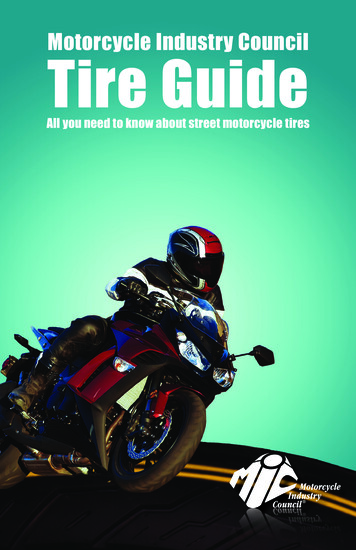
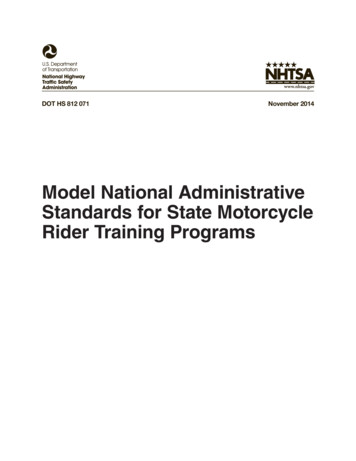
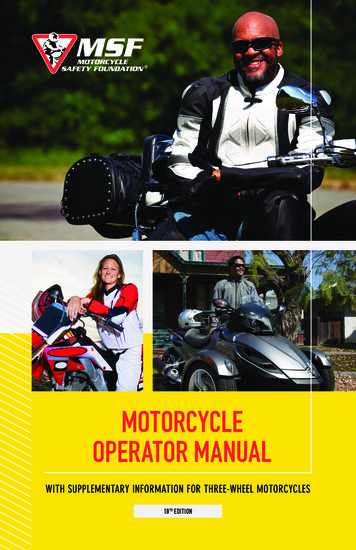

![Motorcycle Mechanic [MM] - CTEVT](/img/5/motorcycle-20-20mechanic-2010.jpg)

